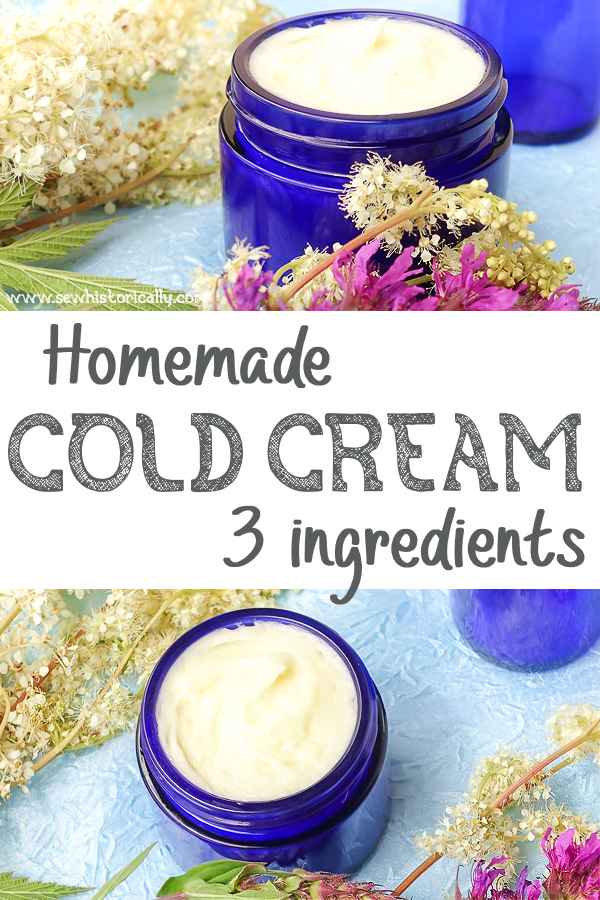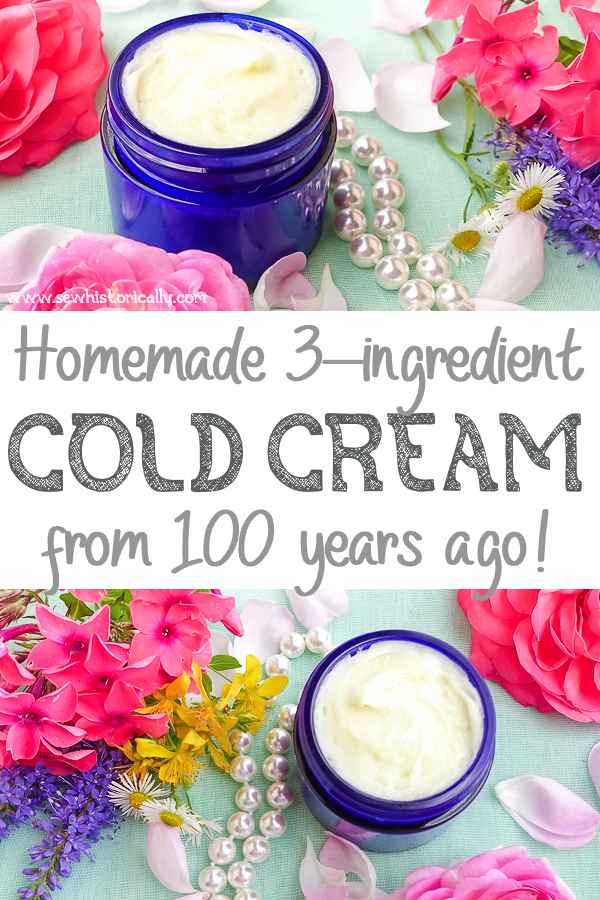Make this easy cold cream with only 3 ingredients. A simple & easy recipe from over 100 years ago for a perfect natural homemade moisturizer for today!
Cold cream has a long history: It has been used for 2000 years! This homemade 3-ingredient cold cream is the best historical or modern cold cream recipe I’ve tried so far! 😀 After making it for the first time, I liked it so much that it replaced all my store-bought hand and face creams. I now make it all the time for the whole family! And homemade cold cream is also a perfect gift.
The natural DIY cold cream is easy to make at home with only 3 ingredients. It’s a very nourishing cream – a water-in-oil emulsion – with a long shelf life. The homemade cold cream is based on a recipe from the Edwardian era (1910) and it’s also very similar to a recipe from the Victorian era (1853).
For What Can I Use Homemade Cold Cream?
This homemade 3-ingredient cold cream works great to moisturize the skin. You can use it:
- as face cream
- as hand cream
- to protect the skin in summer and winter weather
- as primer before applying make-up
- to cleanse the face
- as body lotion
- as rich night cream
8 Historical Uses Of Cold Cream
‘The first step in the proper cleansing of the face is to smear it well with a little rather thin good cold-cream […] Then wipe off the cream carefully with bits of the cotton. […] Soap a square of cotton with a pure Castile soap and wash off the cream […]
Following this, a good cream should be stroked in very carefully […] which is allowed to remain on all night.’ (Every Woman’s Encyclopaedia, 1910-2)
Related: 5-Step Nighttime Skincare Routine From 100 Years Ago
Historically, cold cream was used:
- as moisturizer
- as face cream before applying make-up
- to remove make-up
- to cleanse the face
- together with powder as homemade sunscreen
- to protect the skin from cold and harsh weather
- as shaving cream
- to treat rough skin
‘Make-up should also be built up on a basis of a good cream or grease, as this at once protects the skin and facilitates the removal of the makeup when its use is over.’ (Every Woman’s Encyclopaedia, 1910-2) ‘Start the cosmetic toilette […] rub in cold cream […] The rouge is put on first, the brows and eyelids darkened next, and the powder applied last of all.’ (Sacramento Union, 1909)
Ingredients Of Homemade Cold Cream
I always use organic ingredients to make this natural homemade cold cream.
Beeswax
Beeswax is a natural emulsifier. That’s why most historical cold cream recipes contained beeswax or white wax (bleached beeswax). And even though beeswax is just a weak emulsifier, it’s an all-natural emulsifier unlike most emulsifiers today. Beeswax is essential for this historical DIY cold cream and you cannot leave it out or substitute it! Beeswax thickens the natural cold cream and keeps the oil and water phase of the cream from separating.
Almond Oil
Almond oil is another essential ingredient in historical cold creams. Almost all antique cold cream recipes preferred almond oil to any other vegetable oil. Either because of the benefit for the skin: Almond oil moisturizes and heals the skin making it smooth. It’s also rich in Vitamin E and helps to protect the skin from UV rays. Or they thought almond oil made a whiter cold cream than other more yellow plant oils because white cold creams were preferred in ancient times: That’s why they also often used bleached beeswax instead of natural yellow beeswax.
Rosewater
Rosewater hydrosol has a cooling effect of the skin. That’s why this type of cream was called “cold” cream in old times. But rosewater is not only cooling, it also is soothing, hydrating and anti-inflammatory.
Comparing The Victorian To The Edwardian Cold Cream Recipe
The original Victorian cold cream recipe from 1853 is made with:
- 1 part beeswax (e.g. 7.5g)
- 4 parts almond oil (e.g. 30g)
- 3 parts rosewater (e.g. 23g)
And the original Edwardian cold cream recipe from 1910 is made with:
- 1 part beeswax (e.g. 7g)
- 1 part spermaceti (e.g. 7g)
- 4 parts almond oil (e.g. 28g)
- 4 parts rosewater (e.g. 28g)
I replaced spermaceti with almond oil in the Edwardian recipe above making it 35g of almond oil. So, both historical cold cream recipes – the original Victorian and the adapted Edwardian – are very similar, even almost identical.
Personally, I find the adapted Edwardian cold cream slightly more nourishing. But the Victorian cold cream is also very nourishing. So when you want to try an original historical cold cream recipe, you can make the Victorian cold cream instead.
Substitutes For Homemade Cold Cream
Almond Oil
If you don’t have almond oil at home, you can replace it with other vegetable oils. So far I’ve replaced almond oil with sunflower oil and jojoba oil. And both worked well.
Rosewater
If you want to replace rosewater, you can use other flower waters or herbal waters like orange flower water, lavender water, witch hazel water or peppermint water. You can also make your own rosewater hydrosol at home. It’s an easy recipe and you only need 2 ingredients: fresh rose petals and water.
Related: Homemade Rose Water Hydrosol
And instead of hydrosols you can even use boiled water. This makes a face cream with a very neutral smell: perfect if you’re sensitive to smells or want to add essential oils to your homemade cold cream. Boiling the water kills the germs for a longer shelf life of your homemade natural lotion.
DIY Cold Cream – Troubleshooting
My Cold Cream Separated After Cooling!
This can happen when you didn’t stir the cream until perfectly cold or when you scoop the cream into a jar. But there’s no need to worry! 😉 Simply reheat the cold cream gently over low heat while constantly stirring. Then stir the cream until cold.
My Cold Cream Didn’t Emulsify!
Then you can try a different organic beeswax. Or you can add some jojoba oil or honey: both are natural emulsifiers.
How Much Rosewater Should I Add?
Some DIY cold creams can hold more rosewater and some less depending on the ingredients used. That’s why the recipe below says to add anything between 14g and 28g of rosewater.
To find out how much rosewater you should add, just slowly pour in rosewater while constantly stirring until you notice the cream can’t hold any more water.
Also, when you make your first batch of homemade cold cream, it’s best to use only 14g of rosewater. DIY cold creams with less water content are easier to make. As you become more experienced after mastering your first (few) batches of homemade cold cream, you can add more rosewater.
How Long Does Homemade Cold Cream Last?
Store homemade cold cream in a glass jar in the fridge. This cold cream has a long shelf life: it usually lasts for weeks or even months. I’ve never had a batch go bad so far.
The water and oil phase of cold cream may separate – that’s perfectly normal and you can still use your homemade cold cream. However, if you notice a difference in smell, throw it away.
Homemade 3-Ingredient Cold Cream From 100 Years Ago!
You’ll Need:
- 7g beeswax
- 35g almond oil (or sunflower oil or jojoba oil)
- 14 – 28g rosewater (or other hydrosols or boiled water)
Put oil and beeswax in a pot and melt it over low it. Slowly pour in rosewater while constantly stirring. Keep stirring until the oil and water phase mix. Remove the DIY cold cream from heat and keep stirring until cold. This is necessary so that the oil and water phase don’t separate again.
Related: More Historical Cold Cream Recipes
Please Pin It!


Wow, this looks easy and simple! A couple of questions: Can you make your own rosewater from dried rose petals? Is there any particular kind of oil to look for, or just the kind you can buy in any store?
Thank you! 😀 I’ve made rosewater from fresh rose petals but I haven’t used dried rose petals yet. So I don’t know if it works. And I usually use organic almond oil.
Can methols be added for sunburn relief? If so, would the rosewater be left out? Thank you for anything you may add to help me.
Rosewater is also used for sunburn relief because it’s soothing and cooling. But I’ve never added menthol to the cream so I don’t know if it works. 🙂
Have you ever used essential oils in this recipe? How do you measure those out?
Yes, I occasionally add a few drops of peppermint essential oil to the cold cream. Hope this helps! 🙂